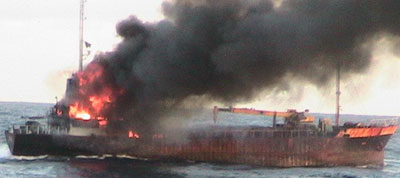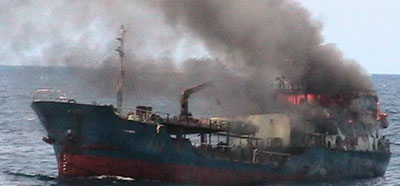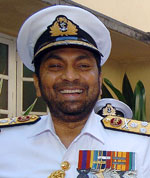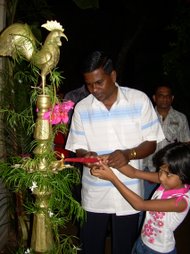Great military victories but Tigers still a threat
* Navy creates history by taking battle to Sumatra waters
* New STF Commandant to replace Lewke; Force will come under IGP
By Iqbal Athas
After Sri Lanka Navy's attack.
1st- MV MANYOSHI.
2nd - MV Scishin
The undeclared Eelam War IV, now raging, has seen a slow but sure increase in the military thrust by the Security Forces against Tiger guerrillas. Since the Government's official claims that the guerrillas have been "completely driven away" from the East, the focus of military actions has been almost entirely in the North. That is not to say the East has fallen silent. Small groups of guerrilla cadres, mostly intelligence operatives, have re-appeared in some parts of the Batticaloa district. In the adjoining Ampara district, there has been a string of skirmishes with the Police Special Task Force (STF) commandos.
They are also moving around in some parts of Trincomalee north. Against this backdrop, Defence Secretary Gotabhaya Rajapaksa on Friday night appointed Deputy Inspector General of Police Mahinda Balasuriya as Commandant of the STF. Substantively Mr. Balasuriya is DIG (Range 3) in charge of the Northern and Eastern Divisions. The Defence Secretary has also brought the Special Task Force under the Inspector General of Police. It was previously under the purview of the Ministry of Defence. Soon after his appointment Mr. Balasuriya rushed to the East yesterday to assess the situation. It is not immediately clear whether the outgoing Commandant, DIG Nimal Lewke, responsible for reforming the STF as a more professional outfit, will remain or be given a new assignment.
In the North, the Security Forces have continued their efforts, particularly ahead of their defended localities west of the Omanthai entry-exit point, located some eight kilometres north of Vavuniya. Moves to seize guerrilla-dominated territory are meeting with heavy resistance. Yet, their efforts continue. Air Force fighter jets have been bombing several locations in the North including Pooneryn, a guerrilla staging area where there has been a reported build up for the past several months. This is for a foray into the Jaffna peninsula.
It is against this backdrop that the Sri Lanka Navy made what is easily one of its biggest achievements - the interception and destroying of three cargo vessels of the Liberation Tigers of Tamil Eelam (LTTE). Two major factors contributed to this effort. The main one was credible intelligence information about the modus operandi of logistics movements of the LTTE. The other is the meticulous planning by the Commander of the Navy, Vice Admiral Wasantha Karannagoda and his senior officers
Launching an offensive operation in the high seas far away from Sri Lanka, lasting almost two weeks, meant food, fuel and military needs had to be carefully accounted for. Equally importantly, utmost secrecy had to be maintained before, during and until conclusion of the operation.
Since the re-capture of Toppigala, there have been no major guerrilla attacks. It came amidst a relative lull in the form of any significant retaliatory response. This drew further attention after the Navy's attack on the LTTE ships. This situation led to many conclusions by influential sections in the Government, both political and military. Some declare that the guerrilla military strength has been completely weakened.
*********************************************************
Vice Admiral Wasantha Karannagoda
********************************************************
They even estimate that it is by over fifty per cent. This has diminished their capability to strike at targets outside the North and East, they argue. Others contend that in the light of this, a military thrust towards the North would virtually finish the LTTE's military capability. Yet others also say the guerrillas were now incapable of staging any attacks in the City of Colombo, suburbs or other outstation areas.
No doubt the Security Forces and the Police (including the Special Task Force) have played a major role in curbing Tiger guerrilla attacks. They have prevented the life of the community from being badly disturbed though it has left in its wake problems for people going past checkpoints or regular searches of premises. The credit goes to them for their vigilance and the sacrifices they make.
However, has the military capability of the LTTE been completely weakened? The question requires a dispassionate appraisal. This is both in the national interest as well as in the interest of the troops who place their lives on the firing line. In raising this question, the idea is not to in any way downplay the importance of the Security Forces and the Police or the vital role they are playing. It is to make sure that the guerrilla military capability is not under-estimated. There have been many such occasions in the past where such underestimation and a consequent "underestimated" response have led to unpleasant consequences. Before examining these aspects, first to the Navy's success story as recounted by a high-ranking officer.
The intelligence had come from different credible sources. The background data were available from confessions made by captured Sea Tiger cadres. Yet, the LTTE ships were operating in the high seas, off the Sumatra coast in Indonesia. The consumption of food and fuel was calculated. The Navy's sea going assets, still meagre, had to be utilised.
A-521, an auxiliary vessel, left the port of Galle on September, 2 (Sunday). This was the former MV Invincible seized for non-payment of Ports Authority dues. Courts had ordered that the vessel he given to the Navy. It was put up for sale by one time Commander of the Navy, Admiral Daya Sandagiri. However, his successor Vice Admiral Karannagoda halted the sale and had this trawler converted by the Colombo Dockyard as a supply vessel. The same day two other Navy vessels set out from Colombo and Trincomalee respectively. They were A 520, also an auxiliary vessel, donated by Sri Lankan well-wishers living in France after the tsunami struck in December 2004. The other was the SLNS Shakthi, a Landing Ship Tanker (LST). The three vessels were taking fuel, water, rations and military cargo.
The next day (Monday September 3) SLNS Suranimala , the Israeli-built Fast Missile Vessel (FMV) set sail from the Eastern Naval Area Headquarters at the Dockyard in Trincomalee. Also heading out from the same port was SLNS Sayura, the Indian built Advanced Offshore Patrol Vessel (AOPV). Departing from the Navy's SLNS Rangala base in Colombo was SLNS Samudura, the former United States Coast Guard vessel "Courageous." This vessel was a gift from the United States and was refurbished in that country at a cost of US $ 10 million (over Rs 100 million).
The Sri Lanka Navy flotilla sailed for almost a week. They had to resort to mid sea re-fuelling to continue their voyage. Arriving at a location in the international waters off Sumatra (Indonesia), the flotilla began their search operations for LTTE vessels beginning midnight on Sunday (September 9). Officers and sailors on board were well briefed on logistics movements of LTTE vessels and the sea-lanes they used.
The first encounter with MV Manyoshi, an old cargo vessel with a crane on board, came at noon on Monday (September 10). Upon confirming that it was one of the LTTE cargo vessels, 76 mm guns on board the SLNS Suranimala began to fire. Others followed engulfing the Aft of the vessel in a ball of fire. Smoke billowed skywards. The second to be hit on the same day was MV Scishin shortly after dusk had set in. Its Aft too was enveloped in black plumes of smoke. It was only before dawn the next day (Tuesday September 11) that the Navy flotilla spotted MV Koshiya, said to be a tanker that was carrying fuel for the LTTE. Navy officials say it was hit and sank early morning. There were no signs of the vessel after the crack of dawn.
A fourth cargo vessel, MV Matsushima, high ranking Navy officials said, could not be located in the vicinity. It was known through intelligence information that this vessel was one of those operating in the deep seas off Sumatra. However, efforts to trace it had not been successful.
Radio intercepts after the attack on the first LTTE vessel MV Manyoshi had revealed there was panic and confusion. Guerrillas on board had at first thought that either United States or Indian Navy vessels known to be carrying out joint exercises in the seas off Andaman and Nicobar Islands had become aware of their movements, trailed them and opened fire.
The long distance at sea prevented Navy Headquarters in Colombo from maintaining regular radio contact with their flotilla. Initial accounts about the encounters reached them by e-mail. Video material on the encounters arrived when the flotilla returned. More debriefs of officers and sailors also followed this week.
According to high-ranking Navy officials, MV Manyoshi was carrying a large quantity of 120 mm mortar shells, fuel for aircraft, a variety of spare parts for vehicles, boats, communication equipment and striped Tiger guerrilla camouflage uniform material. On board the MV Scishin there had been three 120 mm mortar launchers, mortar rounds for them, medical supplies and a variety of canned food items.
As pointed out earlier, the Navy's deep sea operations, for the first time some 1,400 nautical miles away from Sri Lanka, was a remarkable achievement. This is for a number of reasons. The Naval assets put together for this purpose were not state-of-the-art but the best of Navy's meagre resources. In sending out almost all its deep sea going vessels, the Navy took a great risk for two weeks. They were not available during that period if there was any other emergency requirement. They were exposed to grave risk if secrecy over the intelligence information or the operation itself was compromised. Thus, it is a singular victory for the Navy, one that is a first in the Navy's 70 year history. The kudos for that would no doubt go to Vice Admiral Karannagoda, his officers and men. For the LTTE, the loss of military hardware, fuel, the two cargo vessels, the tanker and, above all, trained crew traversing the seas smuggling military hardware is a great loss.
But it must be remembered that despite the heavy losses to the LTTE, last week's deep sea encounter in itself does not alter the military balance. Replenishing their military supplies, where the LTTE is concerned, is an ongoing process. In March 2003, just over a year after the Ceasefire Agreement between the then Government and the LTTE, the Navy sank a guerrilla tanker in the deep seas northeast of Mullaitivu. The vessel was identified as MV Koimar and had been carrying large stocks of ammunition and artillery shells. Thereafter, in June 2003 the Navy sank two more LTTE cargo vessels, each with a deadweight of 600 tons. This was some 200 nautical miles northeast of Trincomalee.
In June 2003, the Navy received credible intelligence information that two guerrilla cargo ships were each towing heavily laden boats. These boats, it was later revealed, had been built in a boatyard in Indonesia. They were being towed until it reached closer to Sri Lankan shores. Thereafter, their engines were powered and the boats were moved to a Sea Tiger base. Among the cargo on board the two vessels were 23 mm anti-aircraft guns, assorted ammunition and artillery shells.
There was a grand welcome ceremony at the Gun Boat Pier in the Dockyard in Trincomalee for the Naval flotilla that took part in the attack on these two cargo ships. The flotilla included the Navy's Israeli built former Fast Missile Vessel (FMV), SLNS Nandimitra, SLNS Ranawickrema, SLNS Ranajaya, SLNS Prathapa and SLNS Udara. Navy Commander Vice Admiral Karannagoda was on hand at the ceremony to receive the return to port of the flotilla.
There have also been instances where inclement weather or other obstacles prevented the Navy from tracking down guerrilla logistics vessels. One such event, where they were almost on the verge of closing in on a big cargo vessel came in May 2003 in the deep seas some 150 nautical miles off the shores of Mullaitivu. This cargo vessel was also towing a heavily laden boat. However, Naval craft lost track of it after trailing it for days.
Under the tenure of the Mahinda Rajapaksa administration, this is the third occasion when the Navy has destroyed guerrilla cargo vessels. The first came in February this year, when a cargo vessel was destroyed in the deep seas south of Dondra. The second, southeast of the same area, came in March this year.
As is clear from the above events, it has been a practice for the LTTE to change the modus operandi of its logistics movements periodically. More so, after the latest attack by the Navy bared detailed information of its operational activities. For over two years now, there has been considerable concern in the defence and security establishment that the LTTE was using hideouts in Indonesia.
Last year, Prime Minister Ratnasiri Wickremanayake flew to Jakarta for a meeting with Indonesian President Susilo Bambang Yudyono. As a special envoy of President Rajapaksa he raised issue over this matter. The Indonesian authorities had assured co-operation but urged that specific instances be made available to them. Government sources said yesterday that a full dossier that will include details pertaining to the Navy's recent attack was now being formulated.
An instance where the pattern of LTTE logistics movements changed became known recently. This was after reports that the guerrillas were using hideouts in the neighbouring southern Indian state of Tamil Nadu as a "transhipment facility." After stockpiling military supplies there, they were using the shallow Gulf of Mannar to smuggle them into Sri Lanka across the western seaboard. The Sea Tiger base at Viduthaltivu is known to play an important role in this regard, according to intelligence sources. This is causing considerable concern to the Security Forces in view of the induction of some quantities of military supplies through this sector.
Another was the shores of Silavathurai, located north of the Wilpattu National Park. Here the Tiger guerrillas had regularly maintained a mobile presence to take delivery of military supplies smuggled from Tamil Nadu. They considered it safe since larger Navy patrol craft could not traverse the Gulf of Mannar due to the shallow seas. The fact that there was no major permanent guerrilla presence in the area was proved after the Security Forces conducted a complete sweep of the area.
This came after the LTTE demonstration of its air strike capability early this year. During the recent military offensive, an LTTE intelligence cadre and a member of the political wing were among those killed. A "suicide boat" and 39 other boats were seized. Security Forces are to now return the boats said to belong to the civilians.
The fact that the Tiger guerrillas have not engaged in any major military attacks in the recent months, particularly after the re-capture of Toppigala in July this year, means they have not expended vast quantities of ammunition. Even the use of mortar and artillery has been less. The main reason for this is the undivided attention to meet a feared military thrust to the North, either from south of the Jaffna peninsula or northwards from the defended localities astride the entry-exit point at Omanthai. The latter, they fear, would be either from the Mannar side or from the Weli Oya end. That pre-occupation has been militarily uppermost to them.
That is why a considerable strength holed up in the jungles of Toppigala were ordered to return to the North. These cadres were earlier on the hop when the Security Forces seized Sampur, Vakarai and later made their foray into Toppigala. Intelligence sources confirm that in the light of this triggering off any major incidents, be it in the North, East or areas outside including the City of Colombo became low priority. Stepped-up efforts to stockpile more military supplies, needed when they come under heavy pressure from the Security Forces, are also for the same reason.
"That scenario is beginning to change somewhat," says a high-ranking intelligence source who spoke on grounds of anonymity. He says, "The string of Air Force bombings has increased the pressure on them. That is why they have stepped up their propaganda campaign to complain about attacks on civilians. This, no doubt, could be laying the groundwork for an attack in the City of Colombo or suburbs. They have already said they would go for both military and economic targets." In fact, the Tamilnet website has posted pictures of alleged civilian victims of bomb attacks and claimed they had fallen on civilian homes.
LTTE's Political Wing leader S.P. Tamilselvan broke silence during past months to tell Tamilnet that it has been intentional. It may be rhetoric. But it is not rhetoric that is to be dismissed. Despite the attacks on the ground, at sea and by air, Tiger guerrillas retain a military capability. Whilst strongly acknowledging the brave role of the Security Forces and Police to deal with them, the truth of the threats posed by the guerrillas should not be buried by heaps of propaganda. Those who do so are fooling only themselves.
Vice Admiral Wasantha Karannagoda
"Star Lanka Online" Our NEW Web site And Web TV Channel Launched
TFGE , The Future Global Educational Center Has Launched
the official web site, called
*** Star Lanka Online Dot Com ........................
www.starlankaonline.com will be completed in very near future....
*** Star Lanka Online TV Channel,..................
Just One Click ahead ...
Now you can watch "Star Lanka Online TV" channel broadcasts from Matara, Sri Lanka in most part of the day. Still we are keeping a test transmission also. There is a link right side of your hand to watch our TV channel. You can watch (Click On the Box) live channel on this site without going to another site to watch the TV. and also recorded parts, following the below link.
the official web site, called
*** Star Lanka Online Dot Com ........................
www.starlankaonline.com will be completed in very near future....
*** Star Lanka Online TV Channel,..................
Just One Click ahead ...
Now you can watch "Star Lanka Online TV" channel broadcasts from Matara, Sri Lanka in most part of the day. Still we are keeping a test transmission also. There is a link right side of your hand to watch our TV channel. You can watch (Click On the Box) live channel on this site without going to another site to watch the TV. and also recorded parts, following the below link.
Place your Own Ad Here
Thursday, September 27, 2007
Great military victories but Tigers still a threat : Situation Report
Subscribe to:
Post Comments (Atom)





















































No comments:
Post a Comment